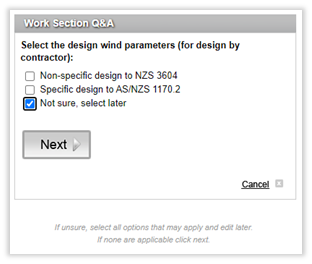We have been alerted to a recent project specification prepared using incorrect design criteria. The project image clearly showed a five-storey residential apartment building, with the envelope constructed predominantly from structural precast concrete wall panels. The exterior window joinery specification section was completed by the designer indicating that the wind actions were in accordance with the wind zone parameters of NZS3604, table 5.1!
It is vital that Movement and Deflection criteria are correctly defined in the Specification. We cannot over emphasize the importance of correctly referencing codes, industry standards and performance requirements in window specifications.
Key Structural Design Standards
Non-specific design
Standard NZS 3604 sets out the construction requirements for light timber-framed buildings in New Zealand that do not require specific structural engineering design. By limiting the size of the building and scope of application, a series of solutions are presented, enabling a designer to select an element or detail appropriate to the situation without needing to engage a structural engineer. Its scope is limited to timber framed buildings up to a maximum of three storeys in height with attic spaces and where there is “good ground.”
Specific structural design
Standard AS/NZS 1170.2 sets out procedures for determining wind speeds and resulting wind actions to be used in the structural design of structures subjected to wind actions other than those caused by tornadoes. To be read in conjunction with AS/NZS 1170.0. This design work must be carried out by a Structural Engineer.
The question - how could an incorrect design standard be referenced?
The answer is simple. The Masterspec proforma specification details reference documentation relevant to all project scales and in this situation both non-specific and specific structural design for wind. When the work section is first downloaded to a project, the designer is presented with the Q&A function to enable the section to be customized and made “project specific”, by the designer. Before commencing the Q&A, a good level of knowledge and competence is necessary to prepare a technical specification- understanding the project’s location and environmental context, scope, scale, materiality etc.
The Masterspec Q&A feature can be a time saver when used correctly. It automatically pre-edits and effectively removes clauses not valid to your design. When used incorrectly it can potentially remove relevant clauses! The Q&A steps are devised in consultation with the Manufacturer and industry experts to allow you to enter only the information pertaining to your design without leaving out key points vital to the specification.
The Q&A function can be re-run at any time as the project (and specification) develops and more detail is known. If the designer is unsure of the Q&A question, we strongly recommend not guessing the answer and running the risk of getting it very wrong! If unsure, always tick “Not sure, select later” and all clauses (without any pre-edit) will be displayed in the work section. Please remember to re-run the Q&A to make the work section “project specific” prior to completion/ issue.

Figure 1: Work Section Q&A Screenshot
The ‘Work Section Support’ function is also another effective way to confirm the correct specification for your project directly with the supplier/ manufacturer.

Figure 2: Work Section Support button
The importance of a good specification
It is important to write clear and concise specifications utilising the resources of manufacturer’s representatives to clearly convey the design and performance intent of the drawings.
Windows represent a relatively large component of a project’s budget, ranging from five to ten percent or more. Therefore, window specifications that are not clear and concise could create wide price and performance variations, resulting in significant cost and time delays once the project commences. Specifications help to maintain both the material and labour budget for a project, mitigate project delays, and set expectations regarding the aesthetics and performance of the finished building product. Importantly it will demonstrate how the product or system will meet the relevant codes & standards for the specific site conditions.
What is the quality standard for windows in New Zealand?
There's a strict quality standard for windows and doors in New Zealand NZS 4211:2008 Specification for Performance of Windows. The New Zealand Building Code, clause E2/VM1, 1.2c requires that window and door units be manufactured and tested to NZS 4211 to the relevant wind zone.
Although NZS 4211:2008 was recently updated to SNZ TS 4211:2022 Specification for performance of windows, the 2008 version is still cited in the NZ Building Code and remains part of the compliance pathway.
The Standard specifies requirements for the performance of windows to be installed in exterior walls within the wind pressure limitations of the wind zones defined in table 5 and table 6. The properties covered are strength, stiffness, operating facility, air infiltration, and water penetration. This Standard specifically excludes skylights or roof windows, interior windows, fixed louvres, the weathertightness of the window perimeter in the external wall or façade, the fire rating, building facades, and durability.
NZS 4211 is particularly related to buildings not requiring specific design (for example those buildings are covered by NZS 3604) and the wind zones used are derived from NZS 3604 except that a nominal ‘Extreme’ wind zone, up to Ultimate Limit State (ULS) 2500 Pa, is provide d for excessively exposed building sites. Establishing that the ULS pressure is above the Very High wind zone of NZS 3604 and within the nominal ‘Extreme’ zone becomes the responsibility of the building design engineer using calculations in accordance with AS/NZS 1170.
Conclusion
Masterspec has unedited clauses which relates to both non-specific and specific design requirements.
Examples as follows:

Figure 3: An example of an unedited non-specific design clause.
 Figure 4: An example of unedited specific design clause.
Figure 4: An example of unedited specific design clause.
Ensure that the specification is pre-edited correctly using the Q&A function and further customised as necessary to reflect your ‘project specific’ requirements. Where specific engineering design is a requirement, include a reference to the engineers ‘schedule of movements and deflections’ document and add a general note in the clause ‘refer to Structural Engineer’. Ensure that a copy of the schedule is appended to the contract appendix for ease of access by all parties.